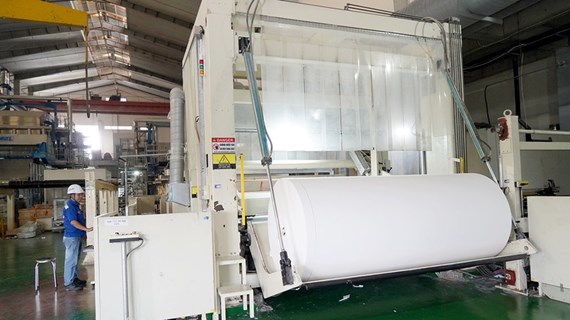Village’s mysterious mask dances intrigue
Performers of Xuan Pha Dance wear
painted masks and don strange costumes while they sing and dance, and
sometimes howl, causing viewers to feel as if they are in some kind of
wonderland.
Performers of Xuan Pha Dance wear
painted masks and don strange costumes while they sing and dance, and
sometimes howl, causing viewers to feel as if they are in some kind of
wonderland.
Xuan Pha dance is held on the 10 th and 12 th days of the second month of the lunar calendar in Xuan Pha village, Tho Xuan district, in the central province of Thanh Hoa .
Xuan Pha is a traditional dance with many mysterious elements, which has been handed down through many generations. One part of the dance consists of rituals worshipping the village god, Dai Hai Long Vuong, a meritorious official of the Dinh and Tien Le dynasties in the 10 th century.
In the past, the Xuan Pha dance called for the participation of residents from five villages, each in charge of one of the dances.
Artisan Bui Van Hung says that after they apply the make-up, viewers cannot recognised who is who.
“Even my family members cannot recognise me among the other dancers,” says Hung.
“In my village, no one dare to watch the dance alone, because they were afraid of nightmares.
There are five dances: Chiem Thanh, Hoa Lang and Tu Huan (where the dancers wear mask), along with the Ai Lao and Ngo Quoc dances.
All of the masks are very strange. Local children say “they look like ghost faces”. The masks are made of wood or cowhide.
And the dancers wear hats made of bamboo or cowhide as well.
As for the Ai Lao dance, the dancers perform as elephants, tigers, lords, servers and soldiers.
The Ngo Quoc dance has two fairies, a lord and ten soldiers, and it is performed with fans and oars.
These dances mix royal and folk elements, which are symbolic and mysterious, and manifest the farmers’ aesthetic view points.
According to music researcher Professor Pham Minh Khang, the Xuan Pha dancers were invited to Hue to serve the king and mandarins several times.
“Each performance had about one hundred dancers. Even in 1935, the French regime intended to organise a trip for the dancers to perform in Paris .”
In the past, the dances were performed in front of the temple dedicated to the village god, but the temple has since been destroyed.
Since the art form was restored in 1990, due to a lack of sacred space, they can only perform some parts of the performance. They can only perform the dances on the stage of the communal cultural centre, or in the yard of the Tau Pagoda, 150m north of the former temple./.
Xuan Pha dance is held on the 10 th and 12 th days of the second month of the lunar calendar in Xuan Pha village, Tho Xuan district, in the central province of Thanh Hoa .
Xuan Pha is a traditional dance with many mysterious elements, which has been handed down through many generations. One part of the dance consists of rituals worshipping the village god, Dai Hai Long Vuong, a meritorious official of the Dinh and Tien Le dynasties in the 10 th century.
In the past, the Xuan Pha dance called for the participation of residents from five villages, each in charge of one of the dances.
Artisan Bui Van Hung says that after they apply the make-up, viewers cannot recognised who is who.
“Even my family members cannot recognise me among the other dancers,” says Hung.
“In my village, no one dare to watch the dance alone, because they were afraid of nightmares.
There are five dances: Chiem Thanh, Hoa Lang and Tu Huan (where the dancers wear mask), along with the Ai Lao and Ngo Quoc dances.
All of the masks are very strange. Local children say “they look like ghost faces”. The masks are made of wood or cowhide.
And the dancers wear hats made of bamboo or cowhide as well.
As for the Ai Lao dance, the dancers perform as elephants, tigers, lords, servers and soldiers.
The Ngo Quoc dance has two fairies, a lord and ten soldiers, and it is performed with fans and oars.
These dances mix royal and folk elements, which are symbolic and mysterious, and manifest the farmers’ aesthetic view points.
According to music researcher Professor Pham Minh Khang, the Xuan Pha dancers were invited to Hue to serve the king and mandarins several times.
“Each performance had about one hundred dancers. Even in 1935, the French regime intended to organise a trip for the dancers to perform in Paris .”
In the past, the dances were performed in front of the temple dedicated to the village god, but the temple has since been destroyed.
Since the art form was restored in 1990, due to a lack of sacred space, they can only perform some parts of the performance. They can only perform the dances on the stage of the communal cultural centre, or in the yard of the Tau Pagoda, 150m north of the former temple./.













